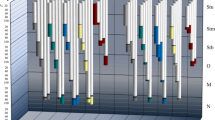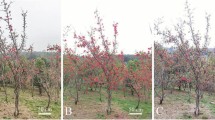Abstract
Tecomella undulata is valued for beautiful flowers, resistance against extreme temperature and drought, stabilizing shifting sand dunes, medicinal properties and wood production. In spite of massive flowering, the species is seedless. The present study examines the causes of its sterility indicating on pollen characteristics. Flowers were hand pollinated by pollen of either self- or outcross pollen. Some flowers were tagged as open pollination treatment. Pollen structure, in situ and in vitro pollen germination and pollen tube growth were analyzed. Mature pollen grains are heteromorphic, mostly heterogeneous sized as small and large. Both pollen grains types are prolate and tricolpate with rugulate–reticulate sculpture. Flowers are protandrous and have long stylus; a nectariferous tissue secreting abundant nectar exists in the ovary base. No effective pollinator visited flowers during the observation period. No pollen germination and pollen tube growth were observed in self- and cross-pollinated styles and under in vitro condition. It seems that pollen heterogeneity, lack of pollinators and pollen limitation, the failure of autogamy due to protandry or long styli as well as self-incompatibility resulted in pollen sterility and seedlessness. In addition, probably polyploidy and cytomixis affect infertility too that needs to be studied in detail in the future.









Similar content being viewed by others
References
Aghdaei M, Salehi H, Sarmast MK (2012) Effects of silver nanoparticles on Tecomella undulata (Roxb) Seem. Micropropagation. Adv Horticult Sci 26(1):21–24
Ahmad F, Khan RA, Rasheed S (1994) Preliminary screening of methanolic extracts of Celastrus paniculatus and Tecomella undulate (Sm.) for analgesic and anti-inflammatory activities. J Ethnopharmacol 42:193–198
Ai HL, Zhou W, Xu K, Wang H, Li DZ (2013) The reproductive strategy of a pollinator-limited Himalayan plant, Incarvillea mairei (Bignoniaceae). BMC Plant Biol 13:195. doi:10.1186/1471-2229
Aizen MA, Harder LD (2007) Expanding the limits of the pollen-limitation concept: effects of pollen quantity and quality. Ecology 88:271–281
Alves MF, Duarte MO, Oliveira PE, Sampaio DS (2013) Self-sterility in the hexaploid Handroanthus serratifolius (Bignoniaceae), the national flower of Brazil. Acta Bot Br 27(4):714–722
Arroyo MTK, Munoz MS, Henriquez C, Till-Bottraud I, Perez F (2006) Erratic pollination, high selfing levels and their correlates and consequences in an altitudinally widespread above-tree-line species in the high Andes of Chile. Acta Oecol l30:248–257
Barros MG (2001) Pollination ecology of Tabebuia aurea (Manso) Benth. and Hook. and T. ochracea (Cham.) Standl. (Bignoniaceae) in Central Brazil cerrado vegetation. Br J Bot 24(3):255–261
Bedi YS (1990) Cytomixis in woody species. Proc Natl Acad Sci India Sect B 100:233–238
Bhandari MM (1990) Flora of Indian desert. MPS Repros, Jodhpur
Bhau BS, Negi MS, Jindal SK, Singh M, Lakshmikumaran M (2007) Assessing genetic diversity of Tecomella undulata (Sm.): an endangered tree species using amplified fragment length polymorphisms-based molecular markers. Curr Sci 93(1):67–72
Bittencourt NS Jr, Semir J (2004) Pollination biology of Zeyheria montana (Bignoniaceae). Plant Syst Evol 247:241–254
Bittencourt NS Jr, Pereira EJ, Sao-Thiago PS, Semir J (2011) The reproductive biology of Cybistax antisyphilitica (Bignoniaceae), a characteristic tree of the South American savannah-like “Cerrado” vegetation. Flora 206:872–886
Brewbaker JL, Kwack BH (1963) The essential role of calcium ion in pollen germination and pollen tube growth. Am J Bot 50:859–865
Burelo-Ramos CM, Lorea-Hernandez FG, Vovides AP (2009) Palynological survey of subtribe Pithecocteniinae (Bignoniaceae, Bignoniaceae). Bot J Linn Soc 159:155–162
Buurman J (1977) Contribution to the pollen morphology of the Bignoniaceae with special reference to the tricolpate type. Pollen Spores 19:447–519
Chauhan SVS, Yadav V, Yada DK (1987) Studies into the causes of seedlessness in some Bignoniaceae. J Exp Bot 38(186):173–177
Datta AK, Mukherjee M, Iqbal M (2005) Persistent cytomixis in Occimum basilicum L. (Lamiaceae) and Withania somnifera (L.) Dun (Solanaceae). Cytologia 70:309–313
Endress PK (1994) Diversity and evolutionary biology of tropical flowers. Cambridge University Press, Cambridge, pp 326–328
Firetti-Leggiere F, Costa IR, Lohman LG, Semir J, Forni-Martins ER (2011) Chromosome studies in Bignonieae (Bignoniaceae): the first record of polyploidy in Anemopaegma. Cytologia 76:185–191
Firetti-Leggieri F, Lohmann LG, Alcantara S, Costa IR, Semir J (2013) Polyploidy and polyembryony in Anemopaegma (Bignonieae, Bignoniaceae). Plant Reproduct 26:43–53
Fischer E, Theisen I, Lohmann LG (2004) Bignoniaceae. In: Kadereit JW, Kubitzki K (eds) The families and genera of vascular plants. Springer, Berlin, pp 9–98
Galetto L (1995) Nectary structure and nectar characteristics in some Bignoniaceae. Plant Syst Evol 196:99–121
Gandolphi G, Bittencourt NS Jr (2010) Sistema reprodutivo do Ipe-Branco–Tabebuia roseo-alba. (Ridley) Sandwith. Acta Bot Br 24:840–851
Gentry AH (1974) Studies in Bignoniaceae XI: a synopsis of the genus Distictis. Ann Mo Bot Gard 61:494–501
Gentry AH (1988) Changes in plant community diversity and floristic composition environmental and geographical gradients. Ann Mo Bot Gard 75:1–34
Gentry, A. H. (1990). Evolutionary patterns in neotropical Bignoniaceae. In: Gottsberger G, Prance GT (eds) Reproductive biology and evolution of tropical woody angiosperms. Memoirs of the New York botanical garden, vol 55, pp 118–129
Ghaffari SM (2006) Occurrence of diploid and polyploidy microspores in Sorghum bicolor (Poaceae) is the result of cytomixis. Afr J Biotech 5:1450–1453
Gibbs PE, Bianchi MB (1999) Does late-acting self-incompatibility (LSI) show family clustering, two more species of Bignoniaceae with LSI: Dolichandra cynanchoides and Tabebuia nodosa. Ann Bot 84:449–457
Guimaraes E, Stasi LC, Maimoni-Rodella RCS (2008) Pollination biology of Jacaranda oxyphylla with an emphasis on staminode function. Ann Bot 102(5):699–711
Gunaga RP, Vasav VP, Narkhede SS (2012a) Seed abortion in Oroxylum indicum: A commercial medicinal tree. Res Rev J Agric Allied Sci 1(1):1–3
Gunaga RP, Kanfade AM, Vasudeva R (2012b) Patterns of seed emptiness among Seed Production Areas of Teak (Tectona grandis) in Karnataka, India. Mysore J Agric Sci 46:164–167
Heslop-Harrison J (1966) Cytoplasmic connexions between angiosperm meiocytes. Ann Bot 30:221–222
Joshi KC, Singh P, Pardasani RT (1977) Quinones and other constituents from the roots of Tecomella undulata. Plant Med 31:14–16
Kumar A, Ram H, Sharma SK, Rama Rao S (2008) Comparative meiotic chromosome studies in nine accessions of Tecomella undulata (Sm.) Seem., threatened tree of Indian desert. Silvae Genet 57(6):301–306
Kumawat R, Sharma S, Kumar S (2012) An overview for various aspects of multifaceted, health care Tecomella undulate Seem. plant. Acta Pol Pharm 69(5):993–996
Lattoo SK, Khan S, Bamotra S, Dhar AK (2006) Cytomixis impairs meiosis and influences reproductive success in Chlorophytum comosum (Thunb) Jacq. An additional strategy and possible implications. J Biosci 31:629–637
Lewis D (1947) Competition and dominance of incompatibility alleles in diploid pollen. Heredity 1:85–108
Liu Y, Hui RK, Deng RN, Wang JJ, Wang M, Li ZY (2012) Abnormal male meiosis explains pollen sterility in the polyploid medicinal plant Pinellia ternata (Araceae). Genet Mol Res 11(1):112–120
Lohmann LG (2002) Bignoniaceae. In: Henderson A, Mori S (eds) Flowering plant families of tropical America. New York Botanical Garden Press, New York
Lopes AV, Vogel S, Machdo IC (2002) Secretory tricomes, a substitutive floral nectar source in Lundia (Bignoniaceae), a genus lacking a functional disc. Ann Bot 90:169–174
Lu Y, Chanroj S, Zulkifli L, Johnson MA, Uozumi N, Cheung A, Sze H (2011) Pollen tubes lacking a pair of K+ transporters fail to target ovules in Arabidopsis. Plant Cell 23(1):81–93
Maués MM, Oliveira PE, Kanashiro M (2008) Pollination biology in Jacaranda copaia (Aubl.) D Don. (Bignoniaceae) at the “Floresta Nacional do Tapajós”, Central Amazon, Brazil. Br J Bot 31:517–527
Moza MK, Bhatnagar AK (2007) Plant reproductive biology studies crucial for conservation. Curr Sci 92(9):1207
Mulcahy GB, Mulcahy DL (1983) A comparison of pollen tube growth in bi- and trinucleate pollen. In: Mulcahy DL, Ottaviano E (eds) Pollen: biology and implications for plant breeding. Elsevier Science, New York
Negi RS, Sharma MK, Sharma KC, Kshetrapal S, Kothari SL, Trivedi PC (2011) Genetic diversity and variations in the endangered Tree (Tecomella undulata) in Rajasthan. Indian J Fundament Appl Life Sci 1(1):50–58
Nirmala A, Rao PN (1996) Genesis of chromosome numerical mosaicism in higher plants. Nucleus 39:15–175
Olmstead RG, Zjhra ML, Lohmann LG, Grose SO, Eckert AJ (2009) A molecular phylogeny and classification of Bignoniaceae. Am J Bot 96(9):1731–1743
Oloumi H, Rezanejad F (2009) Response of pollen tube growth and seed set to controlled pollination and their relation to self-incompatibility in different cultivars of Petunia hybrida. Grana 48(2):102–108
Otto SP (2007) The evolutionary consequences of polyploidy. Cell 131:452–462
Rana A, Chauhan S (2012) Factors affecting reproductive success in Jacaranda mimosifolia D. Don. (Bignoniaceae). Int J Plant Reprod Biol 4(1):79–84
Rao AV, Kiran B, Lahiri AN, Bala K (1989) Influence of trees on microorganisms of aridisol and its fertility. Indian Forestry 115:680–683
Rezanejad F (2009) Air pollution effects on structure, proteins and flavonoids in pollen grains of Thuja orientalis L. (Cupressaceae). Grana 48:205–212
Rodriguez-Perez J (2005) Breeding system, flower visitors and seedling survival of two endangered species of Helianthemum (Cistaceae). Ann Bot 95:1229–1236
Sargent RD, Otto SP (2004) A phylogenetic analysis of pollination mode and the evolution of dichogamy in angiosperms. Evol Ecol Res 6:1183–1199
Shankaranarayan KA, Nanda PC (1963) Cytotaxonomy of Tecomella undulata Seem. Ann Arid Zone 1:174–175
Shivanna KR (1982) Pollen-pistil interaction and control of fertilization. In: Johri BM (ed) Experimental embryology of vascular plants. Springer, New York, pp 131–174
Singh S, Rana A, Chauhan SVS (2009) Impact of environmental changes on the reproductive biology in Pyrostegia venusta Presl. J Environ Biol 30:271–273
Singh VK, Barman C, Tandon R (2014) Nectar robbing positively influences the reproductive success of Tecomella undulate (Bignoniaceae). PLoS One 9(7):102–607
Singhal VK, Kumar P (2008) Impact of cytomixis on meiosis, pollen viability and pollen size in wild populations of Himalayan poppy (Meconopsis aculeata Royle). J Biosci 33:371–380
Singhal VK, Gill BS, Dhaliwal RS (2007) Status of chromosomal diversity in the hardwood tree species of Punjab state. J Cytol Genet 8:67–83
Till-Bottraud I, Joly D, Lachaise D, Snook RR (2005) Pollen and sperm heteromorphism: convergence across kingdoms. J Evol Biol 18:1–18
Totland O, Schulte-Herbruggen B (2003) Breeding system, insect flower visitation, and floral traits of two alpine Cerastium species in Norway. Arct Antarct Alp Res 35:242–247
Tyagi H, Tomar UK (2013) Factors affecting in vitro shoot proliferation and rooting of mature Tecomella undulata (Sm.) Seem Tree. Res Plant Sci 1(2):38–44
Wang Y, Zhang N, Qiang W, Xiong Z, Du G (2006) Effects of reduced ambient, and enhanced UV-B radiation on pollen germination and pollen tube growth of six alpine meadow annual species. Environ Exp Bot 57:296–302
Weber A, Vogel S (1986) The pollination syndrome of Deplanchea tetraphylla (Bignoniaceae). Plant Syst Evol 154:237–250
Wu W, Zheng YL, Yang RW, Chen L (2003) Variation of the chromosome number and cytomixis of Houttuynia cordata from China. Acta Phytotaxon Sin 41:245–257
Zjhra M (2006) New taxa of Coleeae (Bignoniaceae) from Madagascar. I. A collection from Masoala Peninsula. Ann Bot Fennici 43:225–239
Author information
Authors and Affiliations
Corresponding author
Rights and permissions
About this article
Cite this article
Rezanejad, F., Ganjalikhani Hakemi, F. Studies of Pollen Characteristics in Plants of Fruitless Tecomella undulata (Sm.) Seem. (Bignoniaceae) in Golparaki Region of Jiroft City, Iran. Iran J Sci Technol Trans Sci 41, 979–988 (2017). https://doi.org/10.1007/s40995-017-0338-2
Received:
Accepted:
Published:
Issue Date:
DOI: https://doi.org/10.1007/s40995-017-0338-2




